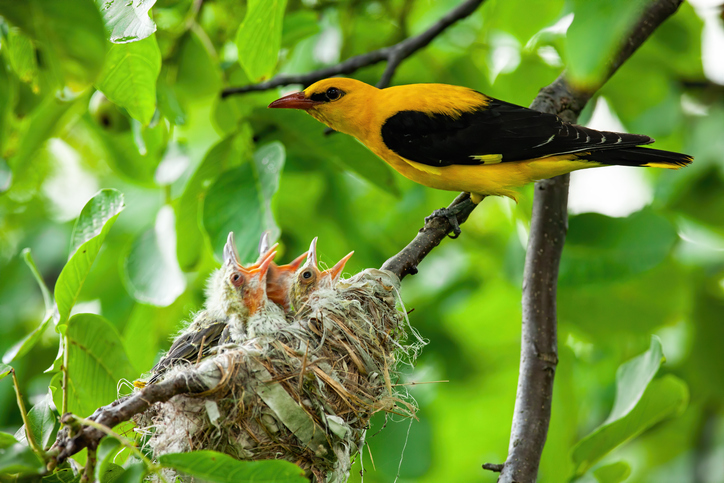Wednesday, 15 January 2020
Brightly coloured male songbirds not only have to attract the female’s eye, but also make sure their sperm can last the distance, according to new research.
In the study, published today in the Royal Society journal Biology Letters, a team of scientists led by Dr Kate Durrant from the School of Life Sciences at the University of Nottingham, looked at how evolution shapes the plumage and the sperm cells of songbird species so that they mate successfully and pass on their genes.
Previous studies have focussed on a bird’s appearance alone, but this is the first study that has looked at this together with the shape of the sperm, to understand if intense competition shapes both plumage (to compete before mating) and the sperm (to compete after mating).
The team looked at 278 species of song bird from around the world and a combination of data on their plumage and the shape of their sperm, to see how they have evolved to ensure successful mating.
The eye-catching plumage of some male songbirds has long been explained as a result of sexual selection: brighter males compete more successfully for mates, and leave more offspring, so evolution favours them. Female birds, by contrast, remain drab, because for them it is more important to be camouflaged on the nest.
How much competition for mates a male song bird faces varies between species, and depends on factors such as the number of available females, how dense the population is, and other things such as the structure of the vegetation they are in.
 Eurasian Golden Oriole
Eurasian Golden Oriole
The intensity of sexual selection varies between species. If mate competition is really strong, not only are males really colourful and attractive, but they also need to have the best sperm too if they are going to compete."
The ‘midpiece’ in the bird’s sperm produces energy-containing molecules, called ATP, to power movement. Previously, experts thought that if the sperm had a large midpiece, it produced a lot of ATP, and the sperm ‘swam’ really quickly and got to the egg first. Whilst this is true in some species, it is not always the case and it is more likely that a large midpiece allows the sperm to last longer, rather than swim faster.
Data on plumage from previous studies were used, together with data on the shape of sperm, for 278 species of song birds. The team found that males from species with more elaborate and colourful plumage, had longer sperm midpieces, which allows the sperm to last for a long time after the male mates with the female, who then stores it for when she is ready to release an egg.
“In a really competitive environment, lots of males are competing with each other for the female’s attention, and there can be a high number that mate with the same female, and this is where sperm and how long it lasts is really important,” said Dr Durrant.
“If a female bird mates with a number of males, she will keep the sperm until she is ready to release an egg. At this point, long-lived sperm can reactivate and fertilise the egg. So it is not enough to be colourful, you have to have the total package and produce sperm that can last.
What we are seeing is what evolution has done to these species to solve the problem of competing for mates."
Story credits
A full copy of the report can be found here.
More information is available from Dr Kate Durrant at kate.durrant@nottingham.ac.uk
Notes to editors:
About the University of Nottingham
Ranked 32 in Europe and 16th in the UK by the QS World University Rankings: Europe 2024, the University of Nottingham is a founding member of the Russell Group of research-intensive universities. Studying at the University of Nottingham is a life-changing experience, and we pride ourselves on unlocking the potential of our students. We have a pioneering spirit, expressed in the vision of our founder Sir Jesse Boot, which has seen us lead the way in establishing campuses in China and Malaysia - part of a globally connected network of education, research and industrial engagement.
Nottingham was crowned Sports University of the Year by The Times and Sunday Times Good University Guide 2024 – the third time it has been given the honour since 2018 – and by the Daily Mail University Guide 2024.
The university is among the best universities in the UK for the strength of our research, positioned seventh for research power in the UK according to REF 2021. The birthplace of discoveries such as MRI and ibuprofen, our innovations transform lives and tackle global problems such as sustainable food supplies, ending modern slavery, developing greener transport, and reducing reliance on fossil fuels.
The university is a major employer and industry partner - locally and globally - and our graduates are the second most targeted by the UK's top employers, according to The Graduate Market in 2022 report by High Fliers Research.
We lead the Universities for Nottingham initiative, in partnership with Nottingham Trent University, a pioneering collaboration between the city’s two world-class institutions to improve levels of prosperity, opportunity, sustainability, health and wellbeing for residents in the city and region we are proud to call home.
More news…